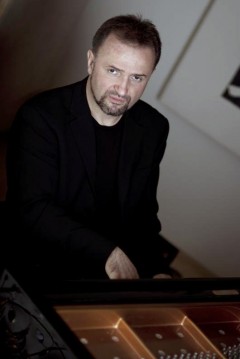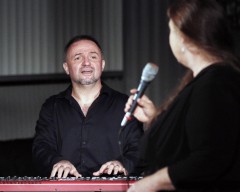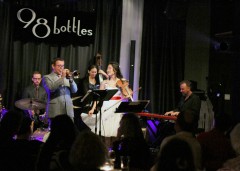Cover Story
Mikan Zlatkovich: Man in the Moment

Mikan Zlatkovich

Z;atkovich with Coral McFarland Thuet. Photo by Dennis Andersen.

Zlatkovich at 98 Bottles with Gilbert Castellanos and Jamie Shadowlight. Photo by Dennis Andersen.
“The time for performing is now. The time for practicing was then,” says Mikan Zlatkovich.
We’re at a Starbucks in the middle of Kearney Mesa. I’ve barely sat down, barely had a chance to grab my pen or get out my notes, and Zlatkovich is already talking to me about his life and his music. I hurry and reach for my notebook. Cessnas and Piper Cubs fly low overhead as they take off from Montgomery Field, and behind us folks line up for their mochaexpensivegrandes or Americanoüberlattes. I quickly get my pen and start stabbing out some notes.
Maybe it’s no surprise that Mikan Zlatkovich takes little time to start our interview. He is a busy man. One of San Diego’s premier jazz pianists, who is known for his dazzling technique and use of often dense harmonies, the San Diego transplant performs regularly at Dizzy’s and other San Diego music spots. He often shares the stage with such local talents as Allison Adams-Tucker Charles McPherson, Chuck McPherson, Bob Magnusson, Rob Thorsen, Gilbert Castellanos, Jamie Shadowlight, and many other notable performers. Both here and in his native Europe, Zlatkovich has performed with a number of well-renowned jazz artists. He has performed with Chet Baker, Tony Scott, Clifford Jordan, Ernie Wilkins, Anthony Wilson, and Willie Jones III.
Zlatkovich is a compact man. Though he confesses that he has no particular exercise regime, he is fit and trim, the way aerobic instructors look. Though he is in his early fifties and his dark brown hair has a touch of gray, he appears to be decades younger. If he ran for president, folks would ask to see his birth certificate, not only to find out where he was born but to see if he met the age requirement, too. He is deliberate when he speaks, gesturing often with his left hand. He has that way, in what seems common to many folks that I know from central and eastern Europe, of nodding his head downward and looking you in the eye as he finishes a statement, in a sort of “did you get that?” expression. Sometimes, when I ask questions, the answers are fairly brief. When I ask him about his experience playing with Chet Baker, he merely says, “It was a gig.”
The trio that Zlatkovich has performed with for the last ten years, Lower Left, just released their first CD last year. Titled Just Sayin’ (reviewed in this issue), the recording features eight standard jazz selections and one original composition. Lower Left includes bassist Bill Andrews and Barry Farrar on drums and percussion. Zlatkovich has served as a sideman on around ten other recordings and has released several recordings of his own. Back in 2010 he released the CD Come Together. Joining Zlatkovich on that disk were electric bassist Kevin Cooper and drummer Russell Bizzett. The fusion funk of the six selections on the disk, which includes a version of the Beatles “Come Together,” is reminiscent of some of Herbie Hancock’s best innovations with a Fender Rhodes.
I first heard Zlatkovich perform about ten years ago. As I recall, it was a Saturday night at Bourbon Street, the gay-friendly nightspot in the hub of University Heights. It was long before University Heights turned into the Gaslamp District Norte that it is now, but Bourbon Street was nonetheless packed wall-to-wall with a mostly young and rowdy crowd.
With a fair amount of difficulty I squeezed through the mass of revelers and got up to the bar for a beer. Once I was up to the rail, it was still hard to get the bartender’s attention. The mood was festive, and the room was pretty noisy. Above the faux brickwork and the beveled glass windows, large flat screen televisions, four in all, were tuned to an auto race. Above the din the formula cars circled a tarmac. No one was watching the TVs.
Unlike just about everybody else there, I had come to hear some music. Over in a corner stood Joe Marillo. A mainstay of the San Diego jazz scene for decades, the man known as San Diego’s Godfather of Jazz, Marillo warmed up on a few scales and licks. Next to Marillo, sitting behind an electronic keyboard was a man with a boyish haircut. He looked out at the crowd that was not looking at him. Marillo launched into “Satin Doll,” and the piano player fell in behind him. Other standards followed. The tunes were bright, bouncy, and exceptionally listenable. It was good straight-ahead jazz. The crowd was not there for the music, but a few seemed to be won over by the duo’s renditions.
I’d known Marillo for quite a few years, catching him often at his Sunday evening gig at Croce’s back when the restaurant and nightspot was in the Gaslamp. On the break he introduced me to his musical partner. “This is Mikan,” he said. I shook the pianist’s hand.
Such was my understanding of this piano player who was new to San Diego. He was a good interpreter of standards and something of a straight-ahead player. A month later at an event held at the Museum of Photographic Arts this image was shattered. Zlatkovich performed with Charles McPherson. McPherson spent years playing in Charles Mingus’ ensemble, and that night, while McPherson played some bop and hard bop, Zlatkovich sounded sometimes like Bud Powell, sometimes like McCoy Tyner. Angular lines gave way to rich chordal passages. It was some of the most inspired jazz that I had heard in a while and certainly a far cry from pleasing a bar full of people with interpretations of standards.
“You always have to fit the gig,” Zlatkovich replies when I relate this story to him. He explains that a musician has to fit the venue and the mood. Musicians are not to play down to an audience; you’re obliged to perform your best but, “You have to be appropriate,” he says. As I get settled in and start to sip my coffee (yes, coffee, plain and simple coffee. I know it’s Starbucks, but it’s just coffee for me.). Zlatkovich keeps talking “It’s all here.” He points to his head. As he speaks, Zlatkovich’s story begins to unfold. He explains that the period of his life of intense musical study and practice has passed. As to what he means about everything being in his head he gives me the story of his life and music.
Mikan Zlatkovich was born in Yugoslavia, back when the Balkan enclave of Europe was still united under the communist leadership of Marshal Tito. His home area is now Kosovo, an independent state that is about the size of San Diego County and features such tourist attractions as ancient castles, aged bridges, and the largest statue of president Bill Clinton in the world (ten feet tall and perhaps the only full statue of Bill Clinton).
Unlike a lot of young jazz musicians who started out playing rock or pop, Zlatkovich started playing jazz right from the get-go, when he was still a small child. His father was an amateur musician, a guitarist. Zlatkovich remembers that his father first tried to interest him in the guitar. “But that lasted only two or three weeks,” he says. The young Zlatkovich felt awkward holding the stringed instrument. Things changed when he was introduced to the piano. He took to the keyboard laid out in front of him.
Zlatkovich’s tutoring in jazz was unusual. Most other jazz musicians receive some mentoring from an older relative or music teacher. Zlatkovich did none of that. From a very early age he listened to jazz recordings and copied what he had heard. He and his father used a reel-to-reel tape player and taped jazz music that came over the radio. The youngster would then play the tapes back and try to repeat note-for-note what the musicians had performed. “I sit there. What is this? The problem was to repeat what I heard,” he says. Zlatkovich would not transcribe the music; he wouldn’t write it down. Rather, he would memorize the music and perform it once he had memorized all of one performance. That is what he means when he points to his head and says, “It’s all here.”
The transcribing and memorization extended beyond pianists to any and every other jazz instrument: trumpets, saxophones, guitars, even basses. “For the bass I would double the speed of the tape playback, so I could hear better what the bass was doing. Doubling the speed would bring the range of the bass up to the guitar range, and I could better hear what the bass player was doing,” he says. “My transcriptions included singers, too. I would try to play what they sang — Ella Fitzgerald and Sarah Vaughn. I love Sarah Vaughn! For some things like when singers or guitar players bend their notes, I couldn’t imitate what they were doing but I still got the notes. As I went along, the transcribing and copying got easier and I built up knowledge.”
As the recordings were only tapes. (For those of you born after 1975, tape used to be a medium for recording music.) The young Zlatkovich did not know the names of the performers that he was emulating. Only later did he find out that his childhood transcriptions were those of Oscar Peterson, Wes Montgomery, Winton Kelly, and other jazz giants.
The method seemed to work. After a while the young Zlatkovich started to see patterns, notes, and phrases that were shared by all the soloists. Although he admits that the recordings of Bud Powell, which contained phrasing and structure that differed markedly from the other recordings, almost escaped his method of analysis. Zlatkovich says that the major influence on his playing is Ahmad Jamal. Zlatkovich admires the famed jazz pianist for his lack of boundaries and ability to reinvent himself.
His methodology of copying recordings failed him on at least one occasion. He wondered why the blues he had transcribed wasn’t working out. It didn’t “fit” on the piano. It turns out that, due to a problem with the tape machine, Zlatkovich had been listening to the recording at the wrong speed. The music had been speeded up and raised the key of the music by a half step. Zlatkovich had been playing the blues in B, a difficult key, instead of B flat, one of the most preferred keys for the blues.
When Zlatkovich was nine or ten he started study at music school in addition to his regular studies. The music school lacked a jazz instruction, but he learned classical and classically based music and played in the school orchestra. In the meantime he was still listening to tapes of Oscar Peterson and Miles Davis. At the time his father encouraged him to learn popular tunes such as the Beatles “Yesterday” or the lounge staple “The Shadow of Your Smile.” He protested that these songs were too simple and did not interest him. But his father made the point, which Zlatkovich remembers as being a good lesson to a musician. “My father told me that it was good to have experience in these things. In order to make good choices, in order to say that you don’t like it, you really have to experience it. You just can’t dismiss and say you don’t like something without some experience of it. I was also learning more at this time. I started listening to the music, not just the notes.”
Around the age of 14 Zlatkovich invested a bunch of money in equipment, buying among other things a Fender Rhoades electric piano, and joined a band. “We played a lot of standard stuff and soul. Earth Wind and Fire and Otis Redding,” he recalls. “I was still in school and still going to music school, too. In the morning I’d go to school, then it was music school after that. The band would play at night. Our gigs went from ten at night till two in the morning. I’d do the gig, come home, sleep, wake up, and go to school and do it all over again. I did that for three years!”
Zlatkovich made a stab at attending a music academy, enrolling twice and leaving twice. The requirement to strictly follow certain rules, rules that Zlatkovich knew were not necessarily followed by jazz musicians, made little sense to him. After leaving the academy for the second time he played with a big band for three years. The one and a half years of compulsory military service that Yugoslavia required of its young men took Zlatkovich away from the big band, although he confesses that he enjoyed the musical experience that the military service gave him. “I was in the military band, and we played all sorts of music,” he says. After the service, at the age of 22, Zlatkovich returned to Belgrade and the big band, staying there for the next six years.
While in Belgrade Zlatkovich secured a regular gig performing at the Hyatt, playing the weekends and a few weeknights from ten until two in the morning. He performed there with a number of musicians, one of which was a singer from the United States. Her stories of America intrigued him and he decided to check out the scene. “If you want to know something, you have to experience it yourself. People will tell you this and that, but you won’t know what someplace is like until you go there yourself. I wanted to see America, so I came here,” he says.
Zlatkovich landed in New York City, a big music town if there ever was one, but the young musician had a language barrier and zero contacts. He got some work by finding the jam sessions and finding a few agents “It’s agents not agent, you need more than one,” he adds. One particularly memorable musical experience was an every Wednesday gig at a Mexican restaurant led by Eddie Hernandez, the East Harlem trombonist. “John Hicks played there as well,” Zlatkovich says. “He’d bring his wife, who was also a great flute player.
“But New York City is too much. It’s too intense. So where to move to? East Coast? West Coast? Let’s see what happens in Los Angeles,” Zlatkovich remembers. He came west and found southern California to be quite different from the Big Apple and liked it. Soon after he drifted down to San Diego and found our town to his liking. He has lived here ever since.
Once in San Diego he met and performed with Margarita Page, the singer who made her home here for many years, and soon thereafter met Gilbert Castellanos. The names of Charles McPherson, Duncan Moore, Bob Magnusson, and other local jazz talents soon filled his Rolodex or cell phone.
When these musicians talk about Zlatkovich, they invariably mention his command of the keyboard, that he is constantly evolving as a musician, and his almost encyclopedic grasp of the essence of jazz performance. One local talent summed up his assessment of Zlatkovich most succinctly, simply saying that the pianist “swings his ass off.”
Local bassist Ben Wanicur hosted a jam session with Zlatkovich for years. He says, “Mikan has that old school attitude, where he’ll just start playing a tune and then call out the key as he begins. He never really explains much of what is going on. He would outline the harmony really clearly. Like he would hammer away on a dominant chord. He also has an excellent sense of rhythm, which makes it easy to play with him.” Violinist Jamie Shadowlight has often performed with Zlatkovich (and was herself the subject of a San Diego Troubadour cover story in October of 2013). She says, “Mikan is great! He never plays the same thing twice!”
I’ve finished my coffee and filled up my notebook from the interview, lots of notes scrawled out as quickly as I could keep up with Zlatkovich. This is going to be difficult; some of my chicken scratch is hard to read. I shouldn’t try to write so fast. We’ve walked out of the Starbucks and Zlatkovich is still talking about music. We are on to the subject of jazz trios. Zlatkovich says, “I love the trios. You know why?” He pauses and gives me one of those “did you get that?” looks before he continues. “Freedom. That’s what you get with a trio. It’s total freedom for all the players. Freedom. That’s what I like.”





